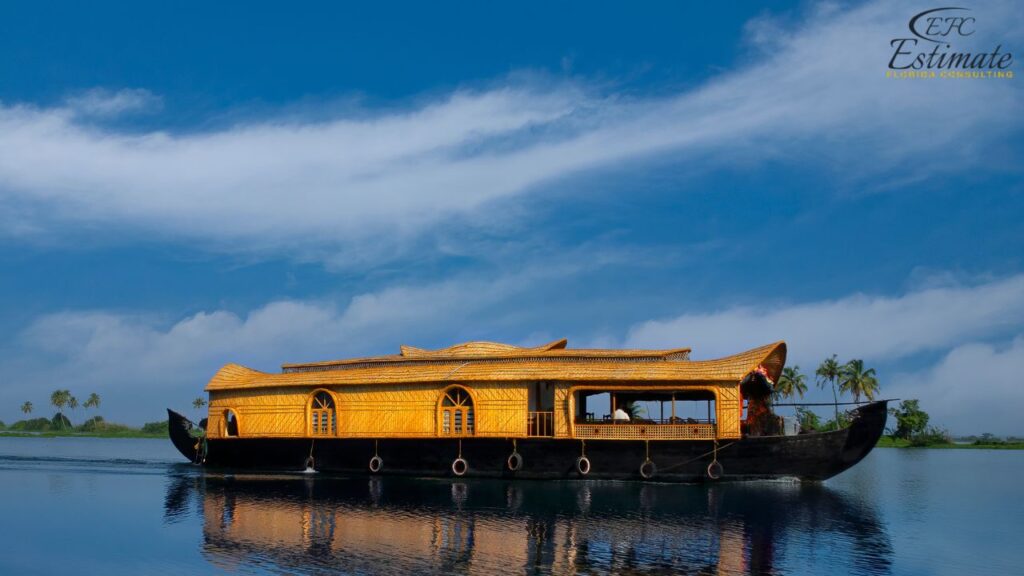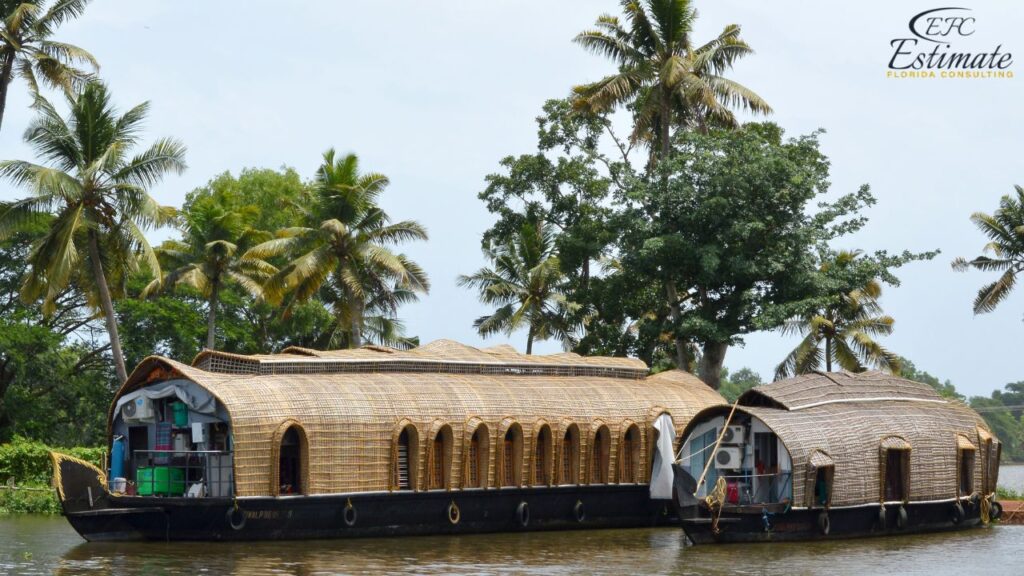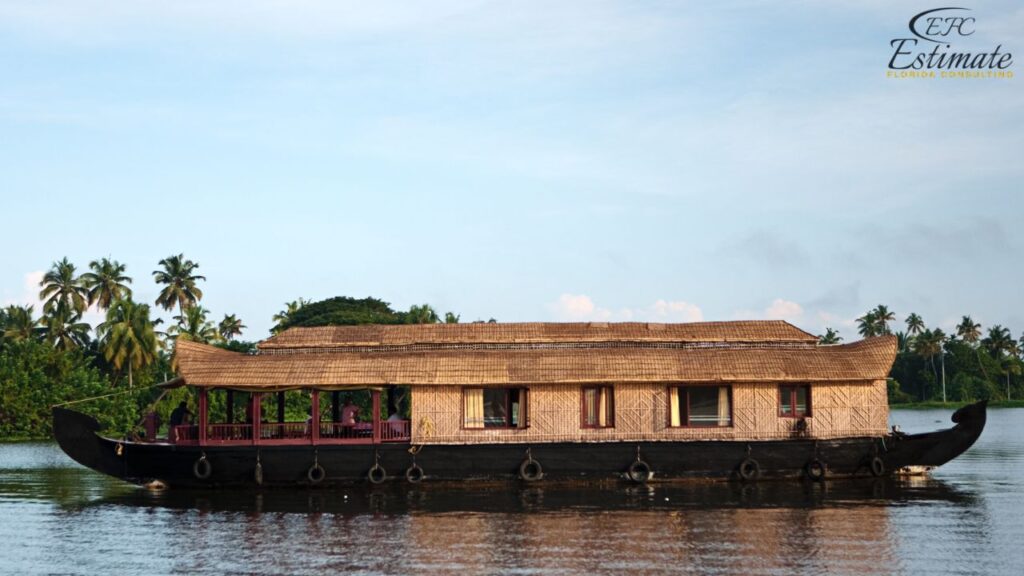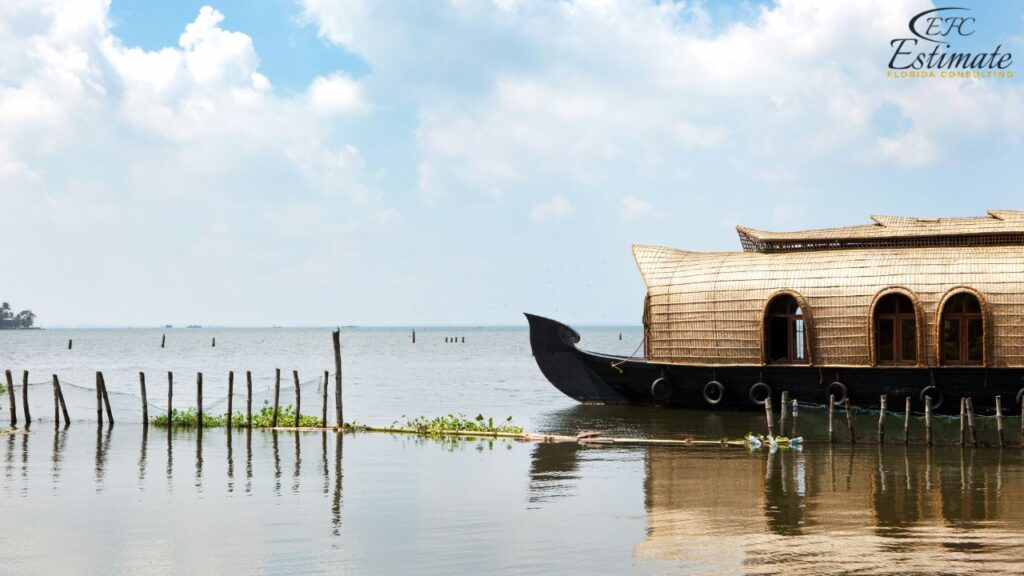How Much Are Boat Houses?
Building a boat house typically costs between $155,000 and $831,300, or about $150 to $500 per square foot. This price includes materials, labor, permits, and features like slips, lifts, and storage. Costs can vary depending on the size, design complexity, material quality, and local labor rates. High-end finishes, custom features, and advanced technology can increase the total cost. Additional expenses might include site preparation, utilities, and landscaping. Investing in a well-built boat house ensures durability, functionality, and increased waterfront property value. Proper planning and budgeting are essential for a successful boat house project.

Types of Boathouses
Basic Boathouse
A basic boathouse is a simple structure designed primarily to protect boats from the elements. These structures are typically open-sided and may include a roof and basic storage. Basic boathouses provide essential protection from sun, rain, and debris, helping to extend the lifespan of the boat. They are often the most cost-effective option for boat owners who need minimal amenities but still want to ensure their watercraft is shielded from harsh weather conditions.
Cost Breakdown for Basic Boathouse
Feature | Estimated Cost per Sq Ft | Total Cost (for 1,000 Sq Ft) |
Structure and Roof | $50 – $70 | $50,000 – $70,000 |
Basic Storage | $20 – $30 | $20,000 – $30,000 |
Enclosed Boathouse
An enclosed boathouse offers more protection and security for boats. These structures have walls and may include additional storage spaces, work areas, and utilities. Enclosed boathouses provide enhanced security, protecting valuable equipment from theft and vandalism. They also offer better protection against the elements, making them ideal for regions with extreme weather conditions. Additionally, enclosed spaces can serve as workshops or areas for maintenance and repair, adding functionality to the boathouse.
Cost Breakdown for Enclosed Boathouse
Feature | Estimated Cost per Sq Ft | Total Cost (for 1,000 Sq Ft) |
Enclosed Structure | $100 – $150 | $100,000 – $150,000 |
Additional Storage | $30 – $50 | $30,000 – $50,000 |
Utilities | $10 – $20 | $10,000 – $20,000 |
Boathouse with Living Quarters
These boathouses include living spaces such as kitchens, bathrooms, and bedrooms. They provide both boat storage and comfortable living areas, often used for recreational purposes. Boathouses with living quarters are ideal for those who want a multifunctional space that serves both as a boat storage facility and a vacation home. These structures can include luxurious amenities and custom features, making them a significant investment but offering substantial returns in terms of comfort and convenience.
Cost Breakdown for Boathouse with Living Quarters
Feature | Estimated Cost per Sq Ft | Total Cost (for 1,000 Sq Ft) |
Living Quarters | $200 – $300 | $200,000 – $300,000 |
Enhanced Utilities | $20 – $40 | $20,000 – $40,000 |
Luxury Features | $50 – $60 | $50,000 – $60,000 |
Boathouse with Living Quarters
These boathouses include living spaces such as kitchens, bathrooms, and bedrooms. They provide both boat storage and comfortable living areas, often used for recreational purposes. Boathouses with living quarters are ideal for those who want a multifunctional space that serves both as a boat storage facility and a vacation home. These structures can include luxurious amenities and custom features, making them a significant investment but offering substantial returns in terms of comfort and convenience.
Materials
Wood
Wood is a common material used in the construction of boathouses. It offers a natural aesthetic and can be treated for durability against water and weather. Wood boathouses blend seamlessly with natural surroundings, making them an attractive option for waterfront properties. However, maintenance is essential to prevent rot and decay, especially in humid or salty environments. Choosing high-quality treated wood can extend the lifespan of the structure and reduce long-term maintenance costs.

Cost Breakdown by Wood Type
Wood Type | Estimated Cost per Sq Ft | Total Cost (for 1,000 Sq Ft) |
Treated Wood | $50 – $100 | $50,000 – $100,000 |
Cedar | $70 – $150 | $70,000 – $150,000 |
Steel
Steel is known for its strength and durability, making it a good choice for boathouses in areas prone to severe weather conditions. Steel structures can withstand strong winds, heavy snow loads, and other environmental stresses better than wood. They are also resistant to pests like termites, reducing the risk of structural damage. Although steel boathouses may have a higher initial cost, their longevity and low maintenance requirements can make them a cost-effective option over time.
Cost Breakdown by Steel Type
Steel Type | Estimated Cost per Sq Ft | Total Cost (for 1,000 Sq Ft) |
Standard Steel | $100 – $150 | $100,000 – $150,000 |
Galvanized Steel | $120 – $200 | $120,000 – $200,000 |
Composite Materials
Composite materials combine the benefits of different materials, providing strength, durability, and resistance to weather and water. They are often designed to mimic the appearance of natural materials like wood while offering superior performance. Composite boathouses are low maintenance and resistant to common issues like rot, rust, and UV damage. While the initial investment in composite materials can be higher, their durability and reduced maintenance needs can result in long-term savings.
Cost Breakdown by Composite Material
Composite Material | Estimated Cost per Sq Ft | Total Cost (for 1,000 Sq Ft) |
Standard Composite | $150 – $200 | $150,000 – $200,000 |
High-End Composite | $200 – $300 | $200,000 – $300,000 |
Construction
Construction labor costs vary based on the complexity of the boathouse. Skilled labor is required to ensure the structure is built to code and meets all safety standards.
High-quality construction ensures the boathouse can withstand environmental stresses and provides a safe and functional space for storing boats and equipment. Detailed planning and precise execution are crucial for achieving a durable and aesthetically pleasing boathouse.

Cost Breakdown for Construction Labor
Construction Task | Estimated Cost per Hour | Total Hours Required | Total Cost |
Basic Construction | $60 – $100 | 200 – 300 | $12,000 – $30,000 |
Enclosed Construction | $70 – $120 | 200 – 300 | $14,000 – $36,000 |
Complex Construction | $80 – $150 | 200 – 300 | $16,000 – $45,000 |
Finishing
Finishing tasks include installing doors, windows, trim, and other final touches. This step is crucial for both functionality and aesthetics. High-quality finishing enhances the overall look of the boathouse and ensures it meets the specific needs of the owner. Proper finishing also includes sealing and painting, which protect the structure from environmental damage and extend its lifespan.
Cost Breakdown for Finishing
Finishing Task | Estimated Cost per Hour | Total Hours Required | Total Cost |
Doors and Windows | $50 – $100 | 50 – 100 | $2,500 – $10,000 |
Trim and Fixtures | $60 – $120 | 50 – 100 | $3,000 – $12,000 |
Additional Features
Boat Lifts
Boat lifts are essential for raising and lowering boats in and out of the water, providing ease of use and additional protection for the boats. They prevent hull damage from prolonged water exposure and make maintenance tasks easier by lifting the boat out of the water. Investing in a boat lift can extend the life of the boat and enhance the overall convenience of the boathouse.
Cost Breakdown for Boat Lifts
Boat Lift Type | Estimated Cost | Total Cost |
Manual Boat Lift | $2,000 – $5,000 | $2,000 – $5,000 |
Electric Boat Lift | $5,000 – $10,000 | $5,000 – $10,000 |
Download Template For Boathouse Project Breakdown
- Materials list updated to the zip code
- Fast delivery
- Data base of general contractors and sub-contractors
- Local estimators

Storage Areas
Additional storage areas in the boathouse provide space for storing boating equipment, tools, and other items. Organized storage helps keep the boathouse tidy and ensures that equipment is easily accessible. Custom storage solutions, such as built-in shelves and cabinets, can maximize the use of space and meet specific storage needs, enhancing the functionality of the boathouse.
Cost Breakdown for Storage Areas
Storage Type | Estimated Cost | Total Cost |
Basic Storage | $1,000 – $2,500 | $1,000 – $2,500 |
Advanced Storage | $2,500 – $5,000 | $2,500 – $5,000 |
Utilities (Electricity/Water)
Installing utilities such as electricity and water can enhance the functionality of the boathouse, making it more convenient and comfortable. Utilities allow for lighting, power tools, and other electrical appliances, as well as running water for cleaning and maintenance. Properly installed utilities increase the usability of the boathouse, making it a more versatile space.
Cost Breakdown for Utilities
Utility Type | Estimated Cost | Total Cost |
Basic Electricity Setup | $1,000 – $2,500 | $1,000 – $2,500 |
Comprehensive Utilities | $5,000 – $10,000 | $5,000 – $10,000 |
Permits and Regulations
Building Permits
Obtaining the necessary building permits is essential for legal and safe construction. Permits ensure that the boathouse complies with local building codes and regulations, which are designed to ensure safety and structural integrity. The cost of permits can vary based on location and the scope of the project.
Cost Breakdown for Building Permits
Permit Type | Estimated Cost | Total Cost |
Standard Building Permit | $500 – $1,000 | $500 – $1,000 |
Environmental Permit | $200 – $500 | $200 – $500 |
Inspection Fees
Inspection fees cover the cost of having the boathouse inspected by local authorities to ensure compliance with building codes. Regular inspections during the construction process can help identify and rectify issues early, preventing costly repairs later. Inspections are a crucial part of ensuring the safety and durability of the structure.
Cost Breakdown for Inspection Fees
Inspection Type | Estimated Cost | Total Cost |
Initial Inspection | $100 – $200 | $100 – $200 |
Mid-Construction Inspection | $100 – $200 | $100 – $200 |
Final Inspection | $100 – $200 | $100 – $200 |

Regulatory Compliance
Ensuring regulatory compliance involves adhering to environmental, zoning, and safety regulations. This may include measures to protect local ecosystems, adhere to setback requirements, and meet fire safety standards. Compliance ensures that the boathouse is built responsibly and sustainably, avoiding legal issues and potential fines.
Cost Breakdown for Regulatory Compliance
Compliance Type | Estimated Cost | Total Cost |
Environmental Compliance | $100 – $300 | $100 – $300 |
Zoning Compliance | $100 – $300 | $100 – $300 |
Safety Compliance | $100 – $200 | $100 – $200 |
Transportation and Handling
Transportation Distance
Transportation costs are influenced by the distance materials need to be transported from suppliers to the construction site. Efficient logistics can help minimize these costs and ensure timely delivery of materials, which is crucial for keeping the project on schedule.
Cost Breakdown by Transportation Distance
Distance | Estimated Cost per Mile | Total Cost (for 100 Miles) |
Short Distance (0-50 miles) | $5 – $10 | $500 – $1,000 |
Medium Distance (50-100 miles) | $10 – $20 | $1,000 – $2,000 |
Long Distance (100+ miles) | $20 – $40 | $2,000 – $4,000 |
Additional Considerations
Seasonal Timing
The time of year can impact the cost and ease of building a boathouse. Scheduling the project during mild weather conditions can prevent delays and reduce complications related to extreme temperatures. This can also affect the availability of labor and materials, potentially leading to cost savings. Planning the project around favorable weather conditions can help ensure timely completion and reduce the risk of weather-related interruptions, which can delay the project and increase costs.

Quality Assurance
Ensuring high-quality construction of a boathouse is essential for its longevity and performance. Implementing rigorous quality control measures during construction can prevent defects and ensure compliance with standards. Regular inspections and testing throughout the process can identify and address issues early, reducing the risk of costly repairs or replacements later. Homeowners should work closely with their contractors to ensure all quality standards are met, ensuring the final product meets their expectations and provides long-term value.
Environmental Impact
Choosing environmentally friendly practices in boathouse construction can reduce the environmental impact of the project. This includes using sustainable materials, optimizing the design for reduced environmental footprint, and implementing waste management practices. Sustainable practices not only benefit the environment but can also enhance the property’s value and appeal to environmentally conscious buyers. Additionally, some environmentally friendly practices may qualify for incentives or rebates, further reducing the overall cost. By prioritizing sustainability, homeowners can contribute to environmental conservation while enhancing their properties.
Financing Options
Financing the construction of a boathouse may involve exploring different financing options such as construction loans, personal loans, or credit lines. Understanding the terms and conditions of these options can help property owners secure the necessary funds. Different financing options may offer varying interest rates and repayment terms, so it’s important to compare your choices carefully to find the most suitable solution for your financial situation. Working with financial advisors can help identify the best financing strategies and optimize funding for the project, ensuring that homeowners can manage the costs effectively.
Cost Breakdown by Financing Options
Financing Option | Estimated Interest Rate Range | Total Interest Cost (for $200,000 loan) |
Construction Loan | 4% – 8% | $8,000 – $16,000 |
Personal Loan | 5% – 12% | $10,000 – $24,000 |
Credit Line | 6% – 10% | $12,000 – $20,000 |
Choosing the Right Contractor
Selecting a reliable and experienced contractor is crucial for the successful construction of a boathouse. Homeowners should research potential contractors, check references, and review past projects to make an informed decision. Choosing the right contractor can prevent delays and ensure that the boathouse meets the necessary standards for quality and durability.
Evaluating Contractor Quotes
When evaluating quotes from contractors, it’s essential to compare the scope of work, materials used, and warranties offered. The lowest quote isn’t always the best option, as it may exclude critical components or use inferior materials. Reviewing the details of each quote helps ensure you’re getting the best value for your investment. Thoroughly vetting contractors can prevent issues and ensure the project stays within budget and on schedule. By obtaining multiple quotes, homeowners can compare prices and services, ensuring they choose the best contractor for their needs.
Get 5 New Leads Next 7 Days With Our System
- Multi-Family House
- Single-Faimly House
- Modern House
- Duplex
- Ranch House
- Bungalow
Checking Certifications and Compliance
Ensure that the contractor holds the necessary certifications and complies with industry standards. Proper certification indicates that the contractor adheres to best practices in construction and quality control, while compliance with regulations ensures that the project meets safety and performance standards. Verifying these credentials can give you peace of mind and protect you from potential issues. Ensuring the contractor is properly certified and compliant can also provide financial protection in case of defects or non-compliance, reducing the risk of additional costs.
Contractor's Track Record
Investigate the contractor’s track record to understand their reliability and reputation in the industry. Look for reviews, testimonials, and case studies from previous clients to gauge their performance. A contractor with a strong track record of successful projects and satisfied clients is more likely to deliver high-quality results. Evaluating the contractor’s past performance can help you make an informed decision and avoid potential problems, ensuring the project is completed to a high standard. By choosing a contractor with a proven history of excellence, homeowners can increase the likelihood of a successful and satisfactory outcome.
Conclusion
Building a boathouse offers numerous advantages, including protection for boats, enhanced storage solutions, and potentially additional living spaces. However, the cost of building a boathouse can vary significantly based on factors such as the type of boathouse, materials, labor, additional features, and site-specific conditions. By understanding and planning for these costs, property owners can create a realistic budget and ensure the successful completion of their boathouse project. Proper budgeting for all aspects of the project helps avoid financial surprises and ensures the boathouse is built to high standards. With careful planning and attention to detail, homeowners can achieve a functional and beautiful structure that enhances the value and enjoyment of their property. Working with experienced professionals and considering all relevant factors can help ensure a smooth and cost-effective construction process for a boathouse. By making informed decisions and choosing the right materials and services, property owners can enjoy the long-lasting benefits of a well-constructed boathouse, providing protection and convenience for their watercraft.
FAQs
Building a boathouse typically costs between $155,000 and $831,300, or about $150 to $500 per square foot. This price includes materials, labor, permits, and features like slips, lifts, and storage.
Factors include the size of the boathouse, design complexity, material quality, local labor rates, and additional features such as high-end finishes, custom features, and advanced technology.
- Basic Boathouse: Provides essential protection from elements, typically open-sided with a roof and basic storage.
- Enclosed Boathouse: Offers more protection and security with walls, additional storage, work areas, and utilities.
- Boathouse with Living Quarters: Includes living spaces like kitchens, bathrooms, and bedrooms for recreational purposes.
- Seasonal Timing: Off-peak seasons can offer better availability and lower costs.
- Quality Assurance: Ensuring high-quality construction prevents defects and extends lifespan.
- Environmental Impact: Using sustainable materials and practices can reduce the environmental impact and may qualify for incentives.
- Financing Options: Exploring home improvement loans, personal loans, or credit lines can help manage costs.
Research potential contractors, check references, and obtain multiple quotes. Evaluate the scope of work, materials used, and warranties offered. Ensure the contractor has the necessary certifications and complies with industry standards.
A well-built boat house provides durability, functionality, and increased waterfront property value. It ensures protection for boats, enhances storage solutions, and can include additional living spaces.
Google Reviews



Process To Get Boathouse Cost Estimate Report
Here I am going to share some steps to get boathouse cost estimate report.
-
You need to send your plan to us.
You can send us your plan on info@estimatorflorida.com
-
You receive a quote for your project.
Before starting your project, we send you a quote for your service. That quote will have detailed information about your project. Here you will get information about the size, difficulty, complexity and bid date when determining pricing.
-
Get Estimate Report
Our team will takeoff and estimate your project. When we deliver you’ll receive a PDF and an Excel file of your estimate. We can also offer construction lead generation services for the jobs you’d like to pursue further.

